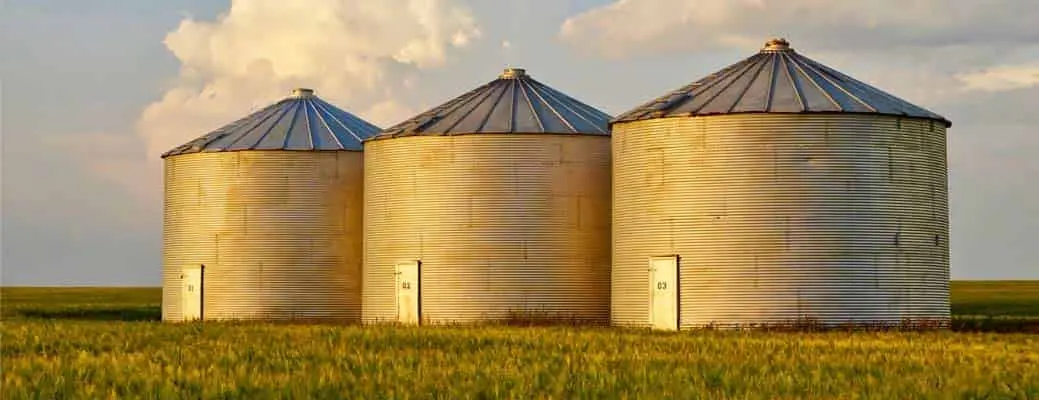Grain Bin Management Tips for Summer


Long-term grain storage can be a real challenge, and it can become even more challenging in the summer months. How long can grain be stored in silos? What are the best ways to manage moisture content in grain storage? Keeping your grain stored is crucial as the outdoor temperatures rise. Plus, depending on the time of year, different walls of the bin could receive more sun and the grain against that wall may exceed the average outside temperatures.
A goal for summer storage is to keep grain as cool as possible, which can help limit insect activity. In an interview with North Dakota State University, agricultural engineer Ken Hellevang noted that insect reproduction is reduced in temperatures below 60 degrees Fahrenheit.
Of course, you want to take every precaution when storing grain long-term. These tips can help you improve your grain bin management system so your grains stay protected during the summer season.
If you want to manage your grain bin effectively, you need to know what the temperature is throughout the bin. That’s a task that requires some thought, since it’s not enough to just take a reading here and there — effective grain bin management requires accurate temperature readings throughout the grain bin. Although temperature sensors are a great tool, they only measure the temperature of the grain that is next to the sensor. Even just a few feet away, the grain could be a much different temperature, and a sensor may not get the most accurate reading. Hellevang has recommended placing a temperature cable a few feet from the south wall of the bin.
In addition to measuring temperatures more accurately, consider keeping aeration fans or ducts covered when they’re not operating. If those openings aren’t blocked, the wind and a natural chimney effect can push warm, moist air through the grain.
Speaking of fans and ducts: managing farm grain storage requires using a grain bin ventilation system to reduce heat inside the bin. Like venting an attic, this provides an air inlet and outlet to reduce the hot air in the top of the bin. The heated air will rise and be exhausted at the peak, so removing it helps keep temperatures cooler. Using a ventilation fan to exhaust the hot air is also an option. If hot air gets stuck under the bin roof, it will heat several feet of grain at the top and lead to hotter temperatures that are far more conducive for insect infestations.
That’s also why it’s important to run aeration fans periodically — even through the spring — to keep grain temperature cool. Running your aeration fan for a few hours to push air up through the cool stored grain will also help cool grain near the top. Try to run your fan every two or three weeks on a cool morning during the summer months. Don’t run the fan for too long or the grain in the bottom of the bin can heat up. As always, cover the fan when it’s not in use to prevent additional heating.
Monitoring your grain moisture content is an important part of grain bin management. Hellevang says that the maximum moisture content in summer varies by the type of grain: 13–14% for corn, 11% for soybeans, 13.5% for wheat, 12% for barley and 8% for oil sunflowers.
Keep in mind that moisture may change while grain is in storage, and there’s always the chance that moisture measurements at harvest may have been incorrect. So, watching moisture levels can help mitigate the possibility for problems later. When you’re checking the moisture content, follow the moisture meter manufacturer’s procedure for obtaining an accurate measurement.
It's a good idea to double-check your moisture meter to make sure everything’s in working order. You can verify the accuracy of your measurement by warming the grain sample to room temperature in a sealed plastic bag before measuring the moisture content. Leaving your sample in a sealed container for six to 12 hours also allows the grain moisture to reach equilibrium across the sample. You can also compare the on-farm measured value to that of the sample using a meter at the elevator or other location.
It’s a good idea to check your stored grain at least every two weeks. Whenever you check on it, measure and record the grain temperature and moisture content. If you see the temperature rising, it may indicate insect or mold problems. Insect infestations can increase from being barely noticeable to becoming a major problem in three to four weeks when the grain is warm, so don’t rely on your temperature cables to inspect for insects or other problems. An effective grain bin management process also includes inspecting for insects, crusting, odors or other indications of storage problems. And of course, be safe when working in grain bins, using proper safety procedures and make sure someone is nearby to assist you.
As the summer heats up, we understand the need to protect your operation. Reach out to your local Farm Bureau agent for more information on how we help with your insurance needs.